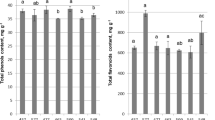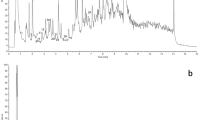Abstract
Changes in phenylpropanoic acid [caffeic, dihydrocaffeic, ferulic, and dihydroferulic acids] and flavonol [quercetin, kaempferol, and isorhamnetin] contents at different growth stages of glasswort (Salicornia herbacea L.) were investigated. Phenylpropanoic acids and flavonols in glasswort were liberated by acid and alkaline hydrolyses, respectively, and their contents before and after hydrolysis were determined by simultaneous octadecylsilane-HPLC. Phenylpropanoic acids and flavonols mostly existed as bound forms in glasswort. Among four phenylpropanoic acids, ferulic acid showed the highest content (ether form, 62.1–105.7 mg/100 g dry wt.; ester form, 241.0–456.6 mg/100 g dry wt.). Kaempferol was the dominant etherified flavonol (108.1–247.6 mg/100 g dry wt.). The total contents of phenylpropanoic acids and flavonols were relatively higher at the mature stage (August and September) when compared to those at the early growth stage. These results provide useful information for phenylpropanoic acid and flavonol content in glassworts grown June to September.
Similar content being viewed by others
Refrerences
Kim CS, Song TG. Ecological studies on the halophyte communities at western and southern coasts in Korea. Korean J. Ecol. 6: 167–176 (1983)
Park IB, Park JW, Lee YJ, Shin GW, Kim HS, Jo YC. Quality characteristic of glasswort (Salicornia herbacea L.) fermented by Bacillus substilis. J. Food Sci. Nutr. 38: 902–908 (2009)
Ha BJ, Lee SH, Kim HJ, Lee JY. The role of Salicornia herbacea in ovariectomy-induced oxidative stress. Biol. Pharm. Bull. 29: 1305–1309 (2006)
Jung BM, Park JA, Bae SJ. Growth inhibitory and quinone reductase induction activities of Salicornia herbacea L. fractions on human cancer cell lines in vitro. J. Food Sci. Nutr. 37: 148–153 (2008)
Kim KR, Choi JH, Woo MH, Kim YH, Choi SW. Effect of enzymatic hydrolysate of hamcho (Salicornia herbacea) on blood glucose and serum lipid composition in streptozotocin-induced diabetic. J. Food Sci. Nutr. 37: 170–176 (2008)
Kim KR, Choi JH, Lee SK, Woo MH, Choi SW. Effect of enzymatic hydrolysate of hamcho (Salicornia herbacea) on antioxidative defense system in rats fed high cholesterol diet. J. Food Sci. Nutr. 35: 1356–1362 (2006)
Im SA, Kim KJ, Lee CK. Immunomodulatory activity of polysaccharides isolation from Salicornia herbacea. Int. Immunopharmacol. 6: 1451–1458 (2006)
Lee KY, Lee MH, Chang IY, Yoon SP, Lim DY, Jeon YJ. Macrophage activation by polysaccharide fraction isolated from Salicornia herbacea. J. Ethnophamacol. 103: 372–378 (2006)
Sung JH, Park SH, Seo DH, Lee JH, Hong SW, Hong SS. Antioxidative and skin-whitening effect of an aqueous extract of Salicornia herbacea. Biosci. Biotech. Bioch. 73: 552–556 (2009)
Lee YS, Lee HS, Shin KH, Kim BK, Lee SH. Constituents of the halophyte Salicornia herbaceae. Arch. Pharm. Res. 27: 1034–1036 (2004)
Chung YC, Choi JH, Oh KN, Chun HK. Tungtungmadic acid isolated from Salicornia herbacea suppresses the progress of carbon tetrachloride-induced hepatic fibrosis in mice. Toxicol. Res. 22: 267–273 (2006)
Kong CS, Kim YA, Kim MM, Park JS, Kim SK, Lee BJ, Nam TJ, Seo YW. Antioxidant activity and inhibition of MMP-9 by isorhamnetin and quercetin 3-O-β-D-glucopyranosides isolated from Salicornia herbacea in HT1080 cells. Food Sci. Biotechnol. 17: 983–989 (2008)
Lee YS, Lee SH, Kim BK, Oguchi K, Shin KH. Inhibitory effects of isorhamnetin-3-O-β-D-glucoside from Salicornia herbacea on rat lens aldose reductase and sorbitol accumulation in streptozotocininduced diabetic rat tissues. Biol. Pharm. Bull. 28: 916–918 (2005)
Kim JY, Cho JY, Ma YK, Park KY, Lee SH, Ham KS, Lee HJ, Park KH, Moon JH. Dicaffeoylquinic acid derivatives and flavonoid glucosides from glasswort (Salicornia herbacea L.) and their antioxidative activity. Food Chem. 125: 55–62 (2011)
Kim UA, Kong CS, Lee JI, Kim HJ, Park HY, Lee HS, Lee CH, Seo YW. Evaluation of novel antioxidant triterpenoid saponins from the halophyte Salicornia herbacea. Bioorg. Med. Chem. Lett. 22: 4318–4322 (2012)
Nuutila AM, Kammiovirta K, Oksman-Caldentey M. Comparison of methods for the hydrolysis of flavonoids and phenolic acids from onion and spinach for HPLC analysis. Food Chem. 76: 519–525 (2002)
Teixeira J, Silva T, Benfeito S, Gaspar A, Garrido EM, Garrido J, Borges F. Exploring nature profits: development of novel and potent lipophilic antioxidants based on galloyl-cinnamic hybrids. Eur. J. Med. Chem. 62: 289–296 (2013)
Lin HP, Lin CY, Liu CC, Su LC, Huo C, Kuo YY, Tseng JC, Hsu JM, Chen CK, Chuu, CP. Caffeic acid phenethyl ester as a potential treatment for advanced prostate cancer targeting Akt signaling. Int. J. Mol. Sci. 14: 5264–5283 (2013)
Matsukawa N, Matsumoto M, Hara H. High biliary excretion levels of quercetin metabolites after administration of a quercetin glycoside in conscious bile duct cannulated rats. Biosci. Biotech. Bioch. 73: 1863–1865 (2009)
Kahle K, Huemmer W, Kempf M, Scheppach W, Erk T, Richling E. Polyphenols are intensively metabolized in the human gastrointestinal tract after apple juice consumption. J. Agr. Food Chem. 55: 10605–10614 (2007)
Li X, Wang XZ, Chen DF, Chen SZ. Antioxidant activity and mechanism of protocatechuic acid in vitro. FFHD 1: 232–244 (2011)
Prathapan A, Singh MK, Anusree SS, Sobankumar DR, Sundaresan A, Raghui KG. Antiperoxidative, free radical scavenging and metal chelating activities of Boerhaavia diffusa L. J. Food Biochem. 35: 1548–155 (2011)
Dey P, Chaudhuri D, Tamang S, Chaudhuri TK, Mandal N. In vitro antioxidant and free radical scavenging potential of clerodendrum viscosum. Int. J. Pharm. Bio. Sci. 3: 454–471 (2012)
Meng J, Fang YL, Gao JS, Qiao LL, Zhang A, Guo ZJ, Qin MY, Huang JH, Hu Y, Zhuang XF. Phenolics composition and antioxidant activity of wine produced from spine grape (Vitis davidii F.) and cherokee rose (Rosa laevigata M.) fruits from South China. J. Food Sci. 71: C8–C14 (2012)
Sun YJ, Qiao L, Shen Y, Jiang P, Chen J, Ye X. Phytochemical profile and antioxidant activity of physiological drop of citrus fruits. J. Food Sci. 78: 37–42 (2013)
Yang XW, Wang N, Li W, Xu W, Wu S. Biotransformation of 4,5-O-dicaffeoylquinic acid methyl ester by human intestinal flora and evaluation on their inhibition of NO production and antioxidant activity of the products. Food Chem. Toxicol. 55: 297–303 (2013)
Fu Z, Yuskavage J, Liu D. Dietary flavonol epicatechin prevents the onset of type I diabetes in nonobese diabetic mice. J. Agr. Food Chem. 61: 4303–4309 (2013)
Ioannou I, Hafsa I, Hamdi S, Charbonnel C, Ghoul M. Review of the effects of food processing and formulation on flavonol and anthocyanin behavior. J. Food Eng. 111: 208–217 (2012)
Kim SS, Park RY, Jeon HJ, Kwon YS, Chun WJ. Neuroprotective effects of 3,5-dicaffeoylquinic acid on hydrogen peroxide-induced cell death in SH-SY5Y cells. Phytother. Res. 19: 243–245 (2005)
Kim HS, Park JW, Lee YJ, Shin GW, Park IB, Jo YC. The amino acid content and antioxidant activities of glasswort (Salicornia herbacea L.). Korean J. Food Preserv. 16: 427–434 (2009)
Bang MA, Kim HA, Cho YJ. Hypoglycemic and antioxidant effect of dietary hamcho powder in streptozotocin-induced diabetic rats. J. Food Sci. Nutr. 31: 840–846 (2002)
Chung YC, Chun HK, Yang JY, Kim JY, Han EH, Kho YH, Jeong HG. Tungtungmadic acid, a novel antioxidant, from Salicornia herbacea. Arch. Pharm. Res. 28: 1122–1126 (2005)
Hwang YP, Yun HJ, Chun HK, Chung YC, Kim HK, Jeong MH, Yoon TR, Jeong HG. Protective mechanisms of 4-caffeoyl, 4-dihydrocaffeoyl quinic acid from Salicornia herbacea against tert-butyl hydroperoxide-induced oxidative damage. Chem. Biol. Interact. 18: 366–376 (2009)
Kim HS, Yoon YS, Cho JW. Quantitative analysis of flavonoids from Salicornia herbacea L. extracts by LC-MS. Korean J. Med. Crop Sci. 16: 231–237 (2008)
Sun GY, Xia J, Xu J, Allenbrand B, Simonyi A, Rudeen PK, Sun AY. Dietary supplementation of grape polyphenols to rats ameliorates chronic ethanol-induced changes in hepatic morphology without altering changes in hepatic lipids. J. Nutr. 129: 1814–1819 (1999)
Nehlig A. The neuroprotective effects of cocoa flavanol and its influence on cognitive performance. Brit. J. Clin. Pharmacol. 75: 716–727 (2012)
Author information
Authors and Affiliations
Corresponding author
Rights and permissions
About this article
Cite this article
Kim, J.Y., Cho, JY., Moon, JH. et al. Change of phenylpropanoic acid and flavonol contents at different growth stage of glasswort (Salicornia herbacea L.). Food Sci Biotechnol 23, 685–691 (2014). https://doi.org/10.1007/s10068-014-0093-5
Received:
Revised:
Accepted:
Published:
Issue Date:
DOI: https://doi.org/10.1007/s10068-014-0093-5




